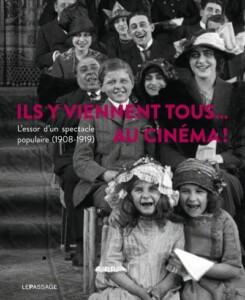
Considering the chronological period 1908-1919 as a pivotal moment in the history of cinema in France, this exhibition catalog explores the different aspects of the production, distribution and reception of moving images at the end of the “Belle Époque”. It is a history of images, that is to say, of imaginations, but also of places and people essential to the development of this new mode of expression that was seeking its place in the cultural field.
The years studied are decisive in the setting up of the modalities of the film show. That is to say, in the elaboration of an industrial and commercial activity and a specific cultural practice prefiguring what we know today. An expression from 1917, “They all come to the movies! (Ils y viennent tous… au cinéma!)”, gives the book its title. It translates, first and foremost, the craze for a leisure activity that was becoming increasingly popular. Indeed, the public’s favor is massively focused on this modern media and the stars it promotes. This is what some people call “the madness of the cinema”. The title also refers to the interest that cinema arouses in stage directors, set designers, costume designers, actors from the theater or music hall, but also painters and musicians for whom cinema is a new springboard. Journalists, intellectuals, writers and poets now want to write or create for the screen, taking into consideration its artistic possibilities. To these, we must add, of course, bankers, industrialists, politicians, soldiers, scientists, laymen and religious people who all realize how interesting the uses of cinema can be, by instructing, by entertaining or by leading the crowd.
This book brings this extraordinarily rich period back to life through a beautiful iconography made up of documents and objects from the collections of several heritage institutions (Cinémathèque française, CNC, BnF, Musée Albert-Kahn, BHVP, ECPAD, Musée Gaumont, Fondation Jérôme Seydoux-Pathé, Bilipo, Archives départementales de la Gironde, Bibliothèque Jacques Doucet, Cinémathèque de Toulouse).
This book is the catalog of an exhibition held at the Gironde Departmental Archives, from November 21, 2021 to March 6, 2022. Click here to access the tour of the exhibition, guided by its scientific curator Laurent Véray.
Table of contents
INTRODUCTION
L’histoire du spectacle cinématographique en France de 1908 à 1919 (Laurent Véray)
LA FABRIQUE DU CINÉMA
La firme Pathé (Laurent Le Forestier)
Innovations techniques: le Chronophone et le Chronochrome Gaumont (Laurent Mannoni)
Arthur Bernède (Alain Carou)
André Antoine (Manon Billaut)
Les opérateurs de fiction dans les années 1908-1914 (Jitka de Préval)
Un cinématographiste tunisien, Albert Samama (Morgan Corriou)
La révolution du Film d’Art (Béatrice de Pastre)
La Société cinématographique des auteurs et gens de lettres (Manon Billaut)
Max Linder (Laurent Guido)
Mistinguett, de la scène à l’écran et retour (Béatrice de Pastre)
Un média moderne sous le contrôle des autorités (Clément Puget)
Les “Archives de la Planète” du banquier Albert Kahn (Anne Sigaud)
La mise en abyme du cinéma (Carole Aurouet)
QUE SIGNIFIE “ALLER AU CINÉ”?
Les salles de projection parisiennes (Laurent Véray)
Les salles de projection bordelaises (Colin Baldet)
Les salles de cinéma dans l’empire colonial français (Morgan Corriou)
Les séances, programmes et affiches des cinémas (Laurent Véray)
Les adaptations musicales de Paul Fosse (Céline Pluquet)
Les attractions dans les salles de cinéma (Laurent Guido)
La presse, carrefour et vecteur privilégié du cinéma (Emmanuelle Champomier)
L’attrait des vedettes de l’écran (Laurent Véray)
La diversité des publics (Laurent Véray)
Louis Delluc le converti (Christophe Gauthier)
Le cinéma forain (Laurent Mannoni)
Le cinéma chez soi (Laurent Mannoni)
QUE MONTRENT LES FILMS ?
Les séries comiques (Laurent Guido)
Les films dramatiques (Mélissa Gignac)
Les vues documentaires et d’actualité (Laurent Véray)
Des films pour le tableau blanc et la propagande laïque et religieuse (Béatrice de Pastre)
La cinématographie de l’invisible (Thierry Lefebvre)
Le cinéma d’expédition (Teresa Castro)
Avant 1916 et le choc du cinéma américain (Christophe Gauthier et Marion Polirsztock)
La révélation de Forfaiture (1916) de Cecil B. DeMille (Laurent Véray)
Être une femme cinéaste: Germaine Dulac (Laurent Véray)
Les expérimentations créatrices d’Abel Gance (Elodie Tamayo)
Les expérimentations créatrices de Marcel L’Herbier (Laurent Véray)
Les films invisibles ou le cinéma rêvé des poètes et des artistes (Carole Aurouet)
ANNEXES
Chronologie – Index – Bibliographie indicative – Liste des documents et objets exposés – Remerciements – Crédits photographiques


